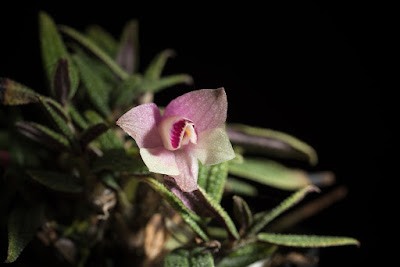Dendrobium cuthbertsonii is native to New Guinea. Plants are found at high altitudes, on mossy trees, on mossy rocks near streams, on cliff slopes, and on commas pointing to the east, where their roots are clinging to a clay substrate under moss, lichens and other small plants covering it.
Dendrobium cuthbertsonii, also called as Cuthbertson's Dendrobium (named after the English Collector in Asia Cuthbertson), Dendrobium agathodaemonis, Dendrobium asperfolium, Dendrobium atromarginatum, Dendrobium carstensziense, Dendrobium coccinellum, Dendrobium euphues, Dendrobium fulgidum, Dendrobium laetum, Dendrobium lichenicola, Dendrobium sophronites, Dendrobium trachyphyllum, Maccraithea agathodaemonis, Maccraithea asperifolia, Maccraithea atromarginata, Maccraithea coccinella, Maccraithea cuthbertsonii, Maccraithea euphues, Maccraithea lichenicola, Maccraithea sophronites, Maccraithea trachyphylla, Pedilonum asperifolium, Pedilonum coccinellum, Pedilonum cuthbertsonii, Pedilonum euphues, Pedilonum sophronites, Pedilonum trachyphyllum, is a species of the genus Dendrobium. This species was described by Ferdinand von Mueller in 1888.
IDENTIFY DENDROBIUM CUTHBERTSONII
Dendrobium cuthbertsonii is native to New Guinea. Plants are found at high altitudes, on mossy trees, on mossy rocks near streams, on cliff slopes, and on commas pointing to the east, where their roots are clinging to a clay substrate under moss, lichens and other small plants covering it. They grow in shady places, but also on mountain peaks in typical alpine habitats where they are exposed to winds. They were also encountered low, even at an altitude of 750 m, but most often occur at heights of 2000-3500 m.
It is a high altitude mossy tree growing, miniature epiphyte or growing as a lithophyte, which reaching the size of 2-8 cm, with clustered, very short, fusiform, 0.5-8.0 cm long stems carrying lanceolate, rough textured, dark green, purple veined below, 0.5-4.2 cm long leaves.
Cuthbertson's Dendrobium is free-flowering with a solitary flower on a terminal to axillary, short, single flowered inflorescence. The flowers are 2.4-4.0, rarely 5 cm in diameter. In the sunlight they are glowing and shiny. The petals of both whorls are usually crimson to purplish-red, but can be purple, pink, orange, yellow or white. Sometimes flowers with two-colored petals are found. The lip is often paler and has darker, reddish-brown spots around the apex. Flowers are distinguished by a variety of sizes and colors.
DENDROBIUM CUTHBERTSONII CARE AND CULTURE
Dendrobium cuthbertsonii usually grows well under the same conditions as the cold-loving genus Masdevallia. High humidity and air movement are particularly important. However, this plant has a reputation for being difficult to care for, and even experienced flower growers say their Dendrobium sometimes dies after years of unproblematic growth. The reasons for this are the short life of this species or abundant flowering, leading to the death of the plant. This species blooms, as a rule, five years after sowing, but there are cases of flowering after 1-2 years after the extraction of the seedling from the greenhouse. It is recommended to remove the first flower from the seedlings immediately after its dissolution, this will allow the plant to regain strength and find additional reserves.
Light:
Cuthbertson's Dendrobium needs a light level of 15000-30000 lux. They can tolerate high levels of light, especially in the morning.
Temperature:
It is a cold-loving plant. Throughout the year, the average day temperature is 22-25 ° C, the average night temperature is 10-12 ° C, with a daily amplitude of 10-15 ° C.
Humidity:
This species needs a humidity of more than 80% throughout the year. High humidity and excellent air movement are very important in growing, especially when the temperatures are higher. It is advantageous to place the plant at the outlet of a cool humidifier or fogger.
Substrate, growing media and repotting:
Dendrobium cuthbertsonii grow best in New Zealand sphagnum, in such medium the roots grow better and are healthier. They can also be mounted on pieces of tree ferns, but they must be often sprinkled and the substrate should never dry up. For the substrate, you can use a small osmunda fern layer on a layer of crumbled pots or chopped tree fern fibers. However, that woody fern decomposes after about 2 years.
Repotting is best done in early spring, when the conditions for active growth are the best. Plants cultivated in the sphagnum should be repotted at least once a year. They should not be divided into small tufts, because the separated part rarely survives if the conditions of detention are not ideal.
Watering:
Water is abundant throughout the year, but the conditions are slightly drier during 3-4 winter months. The substrate of the plants in cultivation should be constantly moist, with little dryness between watering.
Fertilizer:
Dendrobium cuthbertsonii should be fertilized 1/4-1/2 of the recommended dose of fertilizer for orchids. It should be fertilized all year round once a week or once every two weeks using a balanced fertilizer. This species requires little fertilizer, or even not at all, if it is grown in a living sphagnum moss. When cultivating in a different substrate, the fertilizer solution should be very weak.
Rest period:
In winter, the amount of water can be somewhat reduced, especially if the plants are grown in a dark, short day, which occurs in moderate latitudes, but plants should never be completely devoid of water. Occasional morning spraying is very beneficial, especially in the period of bright, sunny weather.

















I have been raising orchids for 25 years and about 4 years ago I acquired dendrobium cuthbertsonii. The plant has florished over the years and has been quite healthy. Recently the leaves have been turning dark purple and falling off. I haven't detected any infestation of any kind and at this point I'm baffled. Any thoughts you may have would be appreciated.
DeleteHello!
DeleteThat does seem a tad odd.
Leaves turn purple in the presence of high light. However if they are also falling off would indicate a sudden change of light intensity that the plant couldn’t keep up with.
Have you moved the plant to different position or installed a light near it ?